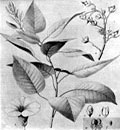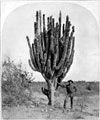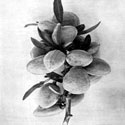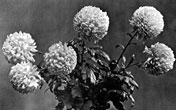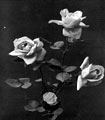Historical Essays on Garden and Forest
Garden and Forest and "Landscape Art"
by Ethan Carr
Pioneers
|
Laura Wood Roper notes in her 1973 biography of Frederick Law Olmsted that the 1890s were years of "staggering reverses" for the profession of landscape architecture. Pioneers such as Frederick Law Olmsted and H. W. S. Cleveland retired from practice, while the untimely deaths of Henry S. Codman and Charles Eliot diminished the next generation.1 But it was also during this period that a body of theory and technical expertise was developed and became the basis for training landscape architects. What had been a practice, in other words, matured into a profession. And much of this transition is documented in the pages of Garden and Forest.
|
Garden and Forest, published from 1888 through 1897, benefited from an extraordinary group of editors and contributors who saw it as their best forum for shaping the profession of landscape architecture. Correspondents included (besides Olmsted, Cleveland, Eliot, and Codman) Beatrix Jones (later Farrand), Samuel B. Parsons, Charles H. Lowrie, Frank A. Waugh, O. C. Simonds, Warren H. Manning, Harold A. Caparn, Wilhelm Miller, J. C. Olmsted-all leading practitioners of the day. Eliot and Codman described European landscapes seen during the travels that had been part of their apprenticeship. Others discussed specific aspects of technique and practice, for example, "The Treatment of Slopes and Banks" (J. C. Olmsted), "Park Construction" (Cleveland), and "The Garden in Relation to the House" (Farrand).2 The editors Charles Sprague Sargent and William A. Stiles published descriptions of showcase projects including the Boston Metropolitan Parks, the World's Columbian Exposition in Chicago, and Biltmore, as well as plans of smaller but typical residences and gardens.3 In an era before a professional organization or academic instruction existed in the field of landscape architecture, Garden and Forest took on aspects of both.
Landscape Architecture
|
The magazine did all this, of course, while also promoting scientific forestry, botany, horticulture, city planning, and scenic preservation; indeed, numerous professions trace their early development in part to the influence of Garden and Forest. But landscape architecture, which aspired to combine planning and design on many scales, enjoyed a special status in the magazine and influenced its editorial structure. Landscape architecture was not limited to the "planting of flower-beds and of ornamental shrubs," the Garden and Forest editors asserted in 1897, but was a "broad and catholic art . . . as useful in the preservation of the Yosemite Valley or the scenery of Niagara as it is in planning a pastoral park or the grounds about a country house."4 Descriptions like these summarized not only the ambitions of landscape architects, but also the editorial goals of Garden and Forest. It was the emphasis on landscape architecture, Stiles felt, that distinguished Garden and Forest from "any other garden paper."5 Stiles and Sargent published articles on horticulture and "country place" design alongside calls for the "Preservation of Natural Scenery" from suburban Boston to the Sierra Nevada.6 In the editorial tradition of Loudon and Downing, readers were urged to expand the aesthetic sensibilities developed in their own gardens and to become advocates for better management of the larger landscape, especially of public parks and forests.
|
If the practice of landscape architecture offered conceptual unity to Garden and Forest, the magazine in turn helped define the emerging theory of the profession. This was largely due to the contributions of the art historian and critic Mariana Griswold (Mrs. Schuyler) Van Rensselaer, who contributed a total of almost 50 articles beginning with a seven-part series on "Landscape Gardening" in 1888. Already an established art critic, Van Rensselaer became intrigued with landscape architecture through her friendship with the elder Olmsted. In her Garden and Forest articles, she set out to define landscape architecture as "landscape art," which, after architecture, sculpture, and painting, constituted the "fourth art" of design.7 To Olmsted's great satisfaction, she helped establish the professional status of landscape architects by defining their practice as a fine art, unlike the craft or trade of gardening.8
Van Rensselaer
|
Continuing this essentially Reptonian discourse, Van Rensselaer distinguished landscape art from the other fine arts by observing that it "uses the same materials as nature herself."9 The landscape gardener (her preferred term) "takes from nature not only his models but his materials and his methods." This "partnership with Nature" might seem to limit the artist’s opportunity for self expression, a necessary quality of true art. But like the painter or the sculptor, the landscape gardener observes nature and "re-unites her scattered excellences" in artistic compositions that express the wholeness and unity that nature possesses but rarely reveals in a single place or view. Nature always provides "vitality, light, atmosphere," she concluded, and especially "what no other artist ever gets—perfection in details." But "composition . . . is the chief thing in art . . . and the landscape gardener’s compositions are and must be his own."10
|
Van Rensselaer’s contributions in Garden and Forest made her a foremost landscape theorist of her day, and her ideas would be taught to generations of American landscape architects.11 If many of her discussions of nature and art would not seem out of place in the late eighteenth century, to a remarkable degree they also anticipated some of today’s debates in the fields of landscape design and planning. Van Rensselaer deplored the naive tendency to assume that rural scenery was "natural," for example, when it was usually the (often unintended) product of generations of cultivation and management. Nature and art were rarely mutually exclusive in the landscape. Sargent and Stiles adopted this theme and criticized the excessive veneration of what was assumed to be natural or "wild" because it had led to the neglect of "that part of the landscape which is necessarily not wild—the landscape of our daily lives—the humanized scenery of the earth." In words that resonate today, they regretted the tendency of people to travel "in search of the picturesque while what might be the picturesqueness of their own neighborhood is unperceived or destroyed."12
True Art
|
Throughout the pages of Garden and Forest, simplistic distinctions between what is "nature" and what is "art" were condemned, as were dogmatic preferences for either the "natural" or the "formal" styles in garden design.13 "Landscape art" encompassed both spheres, which is why it offered a unique means for improving a broad range of public and private environments, from vacation villas to city plans and from municipal parks to national reservations. Landscape art was necessary in all these designs because without it they could never achieve the unity inherent in great artistic compositions. The "true artist" planned landscapes-from gardens to entire cities-by first analyzing and recognizing the "characteristic and salient aspects of the place," in order to "work in harmony with them instead of coming into conflict with nature."14
Garden and Forest was dedicated to advancing landscape design
as a compositional "art," inspired by the greater composition
and unity of "nature" and intended to integrate human society
into the larger, natural environment. Landscape architecture was seen
as the profession that would supply the necessary artists. But landscape
art was not for art's sake alone. In an editorial reflecting the sentiments
of the elder Olmsted (as was often the case) Sargent and Stiles state
that "true art is not the servant of some temporary fashion, but
something that is to endure, and must, therefore, have a permanent basis
in the necessities and aspirations of human life."15
|
Among contemporary landscape projects none received more attention in the pages of Garden and Forest than the Metropolitan Park Commission's system of suburban parks around Boston. Charles Eliot, who first proposed the system in an 1890 letter to Garden and Forest, was praised as an example of the "true artist" needed to successfully direct such a project.16 But the deaths of both Eliot and Stiles in 1897, followed soon by the demise of Garden and Forest, marked the end of one era and the beginning of another. Within three years, landscape architects had established their own professional organization, the American Society of Landscape Architects (1899), and instituted the first academic program in the field, at Harvard University (1900). The profession flourished, bolstered by a growing market for "country place" residential design. Whether Garden and Forest's ideals of "landscape art" survived as well in the new century is yet an open question.
AUTHOR: Ethan Carr is a landscape architect with the National Park Service and the author of Wilderness by Design (University of Nebraska Press), which received the American Society of Landscape Architects' honor award in 1998.
NOTES
1. Laura Wood Roper, FLO: A Biography of Frederick Law Olmsted (Baltimore: Johns Hopkins University Press, 1973), 475.
2. (hereafter, G&F) 1 (1888): 267; 326-327; 3 (1890): 129; 4 (1891): 184; 10 1897): 132.
3. G&F 1 (1888): 508; 6 (1893): 361-362; 8 (1895): 481-482.
4. G&F 10 (1897): 192.
5. Quoted in Roper, FLO, 404.
6. See G&F 2 (1889): 133; 3 (1890): 257; 7 (1894): 1; 10 (1897): 222.
7. The articles, as well as at least one G&F editorial written by Van Rensselaer (6 {1893}: 119-120), became the basis for her book, Art Out-of-Doors: Hints on Good Taste in Gardening (New York: Charles Scribner's Sons, 1893). In 1889, Van Rensselaer began a series of G&F articles on garden history.
8. G&F 1 (1888): 2.
9. The late 18th-century British landscape gardener Humphry Repton (who coined the term "landscape gardener") was a figure of considerable interest to American landscape architects in the 1880s. When J. C. Olmsted, Eliot and others began to meet as an informal professional society at that time, they named their group the "Repton Club." Norman T. Newton, Design on the Land: The Development of Landscape Architecture (Cambridge: Harvard University Press, 1971), 386. Also see Humphry Repton, The Art of Landscape Gardening, John Nolen, ed. (Boston: Houghton Mifflin Company, 1907).
10. G&F 1 (1888): 2, 14-15, 27, 38.
11. Art Out-of-doors was republished in 1925, and many of Van Rensselaer's ideas were assimilated into Henry V. Hubbard and Theodora Kimball's standard textbook, An Introduction to the Study of Landscape Design (1917; rev. ed., New York: The Macmillan Company, 1929).
12. G&F 6 (1893) : 531.
13. See G&F 1 (1888): 51-52, 481; 7 (1894): 261-262, 341-342; 10 (1897): 191-192.
14. G&F 6 (1893): 531.
15. G&F 9 (1896): 171; see Roper, FLO, 435.
16. See G&F 3 (1890): 85-86; 3 (1890): 109, 117-118; 7 (1893): 191.


